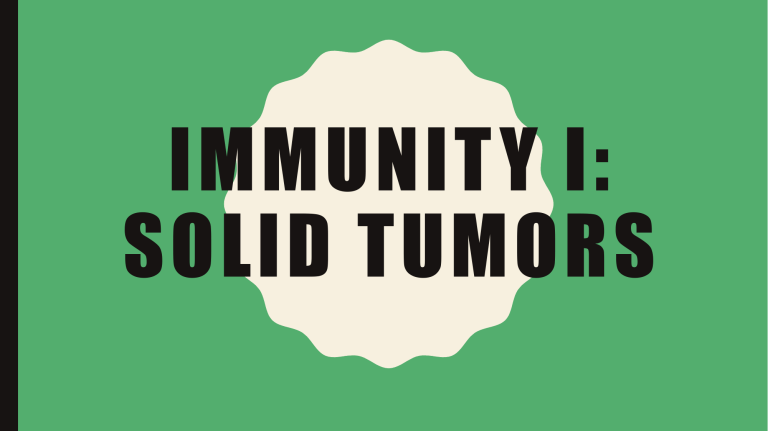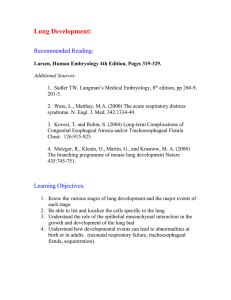
IMMUNIT Y I: SOLID TUMORS EPIDEMIOLOGY • Age • Race • Genetics; breast cancer • Lifestyle; smokinglung cancer, colon cancerlots of red meat • Environment • Other conditions • Social determinants- access to health care could cause cancer to progress and become untreatable • Proto-oncogenes promote cell growth, but… • Mutation (external vs. internal) changes them to… Carcinogenesis • Oncogenes which turn normal cells into cancer cells. Immunology • Immunologic surveillance monitors the body with… • T cells, NK, B cells, macrophages unless… • Immunologic escape through immune suppression, weak/blocked antigens, or tolerance to antigens. SCIENTIFIC BASIS Carcinogenesis And Immunology Carcinogenesis • Angiogenesis creates means for tumors to grow, and • Metastasis allows them to spread further in the body. COMMON METASTATIC LOCATIONS Cancer Type Breast Colorectal Lung Pancreas Prostate Main Sites of Metastasis Bone, brain, liver, lung Liver, lung, peritoneum Adrenal gland, bone, brain, liver, other lung Liver, lung, peritoneum Adrenal gland, bone, liver, lung DIAGNOSTIC MEASURES • Radiographic studies – CT, MRIs, PET scans • Blood work – CBC: WBC count, platelets, hgb, hct, tumor markers (PSA, CA125, HCG).. Do not guarantee a diagnosis TM • Endoscopy: thru mouth • Biopsy • Definitive diagnosis made through tissue examination CLASSIFICATION • Origin tissue • Anatomic site • Nature of tumor • An adenocarcinoma of the lung tells us – Origin: adeno- indicates glandular epithelium – Anatomic site: lung – Nature: -carcinoma indicates malignancy STAGING • Clinical staging used for many tumor types –I local growth small, localized – II local spread some adjacent lymph node involvement – III local/regional spread spread to nearby structures – IV metastasis distant spread TREATMENT MODALITIES • Surgery • Radiation therapy • Chemotherapy • Biotherapy • Immunotherapy • Targeted therapy SURGERY • Prevention – Ex. Mastectomy, hysterectomy, ovaries removed • Cure: tumor removal (stage 1 or 2, maybe 3) • Control/cure – Neoadjuvant: doing the surgery before any tx is done – Adjuvant: after primary tx such as chemo, this is done when tumor is too big to remove initially • Palliation: doing it for comfort (stage 4) RADIATION • Cure/control or palliation • Teletherapy: sends external beams directly to target cancer – Brain, colon, lung • Brachytherapy: small seeds placed in area of cancer with hope to cure – Uterine, ovarian, head/neck, prostate cancer, eye – 2x a day for 2-5 days or once a week for 2-5 weeks • Nursing safety: Remember ALARA and T-D-S! • Common side effects: – Skin desquamation: burning of skin, skin break down (most common) – Others depend on site: diarrhea, mucositis, anorexia, pneumonitis, pericarditis CHEMOTHERAPY • Cure/control or palliation • Regimens created based on effect on cells, toxicity profiles – Cell-cycle phase specific vs. cell-cycle phase non-specific • Drugs can’t distinguish between normal and cancer cells. Side effects result from destruction of normal cells and depend on class of drug. – Most common side effects: myelosuppression, N/V, neuropathy, fatigue • Given IV or regionally: oral, intraperitoneal, intrathecal, intravesicular, intrapleural – direct to tumor site = less systemic toxicity • Nursing safety – Special PPE needed. Chemo typically administered by specially trained nurses. • What is the difference between cell cycle specific and nonspecific? • What impact do growth rate and cell cycle have on an agent’s effectiveness? • Why are CNS tumors difficult to treat? • When is regional therapy most useful? • Why are CVADs recommended for chemotherapy administration? C H E M OT H E R A P Y CRITICAL THINKING QUESTIONS BIOTHERAPY, IMMUNOTHERAPY, AND TARGETED THERAPY: NOT CHEMO • Work differently than chemotherapy – Attack cancer cells via receptors/antigens, inhibit molecules/enzymes, boost immune system – i.e. monoclonal antibodies: bevacizumab for lung cancer, trastuzumab for breast cancer • Side effects – Infusion reactions (fever, chills, rash, dyspnea, etc) – Flu-like symptoms SIDE EFFECT CONSIDERATIONS • Acute vs. delayed vs. chronic – Acute – Delayed – Chronic • Tolerable vs. toxic – Tolerable – managed with interventions – Toxic – dose-limiting (if they are vomiting uncontrollably) • Secondary malignancies – Increased risk with alkylating agents, high dose radiation SYMPTOM MANAGEMENT NURSING ASSESSMENT FINDINGS • Increased intracranial pressure • Constipation • Peripheral neuropathy • Hemorrhagic cystitis: blood in urine • Cognitive difficulties • Myelosuppression, including nadir • Mucositis • Hyperuricemia • Nausea/vomiting • Alopecia- hair loss • Anorexia • Radiation “burns” • Diarrhea • Fatigue ADDITIONAL PSYCHOSOCIAL FINDINGS • • • • • • • • • Pervasive anxiety and fear, loss of control Decisional conflicts: information overload! Relationship stress: altered family roles and isolation Financial burden Altered body image Denial Grief Depression Impaired intimacy and sexual dysfunction NURSING DIAGNOSES • Activity intolerance • Impaired skin integrity • Anxiety • Insomnia • Chronic pain • Nausea • Constipation • Risk for bleeding • Diarrhea • Risk for imbalanced fluid volume • Disturbed body image • Risk for infection • Imbalanced nutrition • Self-care deficit • Impaired oral mucous membrane • Impaired physical mobility SAMPLE NURSING INTERVENTIONS • Neuropathy: – Consider gabapentin, encourage diligent foot care • Cognitive difficulties (a.k.a. “chemo brain”): – Teach regarding avoidance of multi-tasking, use of daily planner • Mucositis: – Teach regarding bland/soft foods, oral care, topical anesthetics • Nausea/vomiting: – Prophylactic and scheduled or PRN antiemetics (Zofran) • Anorexia: – Small, frequent, high-calorie meals, consider appetite stimulant SAMPLE NURSING INTERVENTIONS • Diarrhea: – Administer anti-diarrheals, encourage fluid intake • Constipation: – Administer stool softeners, encourage activity • Fatigue: – Encourage exercise as tolerated, activity pacing and rest • Psychosocial: – Active listening, trust building, support usual lifestyle patterns, networking, family care • Myelosuppression and radiation burns: – See case study ONCOLOGIC EMERGENCIES • DIC • SIADH • Sepsis • Tumor lysis syndrome • Third space syndrome • Cardiac tamponade • Spinal cord compression • Hypercalcemia • Carotid artery • Superior vena cava syndrome rupture METABOLIC , INFILTRATIVE, OBSTRUCTIVE STEP ONE: MOVE TO YOUR COLOR-CODED AREA AND BEGIN DISCUSSION • Light green group up front – Find those with the same oncologic emergency as you and start researching details • Everyone else – Compare your sheets and start deciding which oncologic emergency you are from the previous slide – When you have your answer, see me. If your answer is correct, your “light green” partners will join you! STEP TWO: DECIDE APPROPRIATE NURSING INTERVENTIONS • Use the table provided to decide the best row of interventions for your emergency. • When you have your answer, see me to be awarded the “buff” colored sheet with those interventions • Decide whether your emergency is metabolic, infiltrative, or obstructive • Prepare a 60-second-or-less summary to share with the class including type of emergency, cause/risk, assessment, and intervention STEP THREE: SURPRISE





